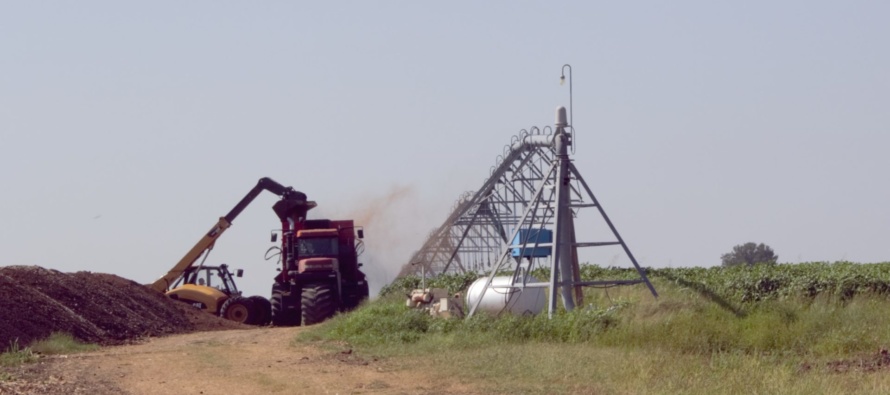Effect of Poultry Litter Applications on Soil Physical Properties

Related Articles
- 2010 Soybean And Corn Variety Trial Data 3
- Fertilizing Cotton with Poultry Litter 5
- Flag The Technology 0
Latest Tweets

Water infiltration study post-poultry litter applications. Photo courtesy of Dr. Gary Feng, USDA-ARS.
Healthy soils have thriving biological populations busy recycling nutrients. Just as good working environments aid human productivity, good working environments foster the soil biological population. Soil physical factors that impact this work environment include aggregation, bulk density, and water holding capacity.
Aggregates are groups of primary soil particles that stick to each other more strongly than to other surrounding particles (they are an exclusive club). Aggregation stability measures the proportion of those aggregates that do not easily dissociate or disintegrate.
Bulk density measures the mass of dry soil per unit of volume that reflects the soil’s functionality for water and solute movement. Bulk density affects water infiltration and storage capacity, effective rooting zones (zones of available nutrients), and microbial activity. Higher bulk densities indicate low porosity and that the soil may be compacted. In turn, compaction means increased bulk density and decreased soil porosity.
Infiltration rate is the volume of water that enters a measured cross-section of soil in an unit of time. The available water in soils – how much water is present after infiltration – is defined as the amount of water between ‘field capacity’ and ‘permanent wilting point’. The actual amount of water plants will use depends on the plant species. The upper and lower soil water content over which water, oxygen, and mechanical resistance do not restrict plant growth is called the ‘nonlimiting water range’.
Note: visit the Soil Science Society of America Glossary for soil science terminology.
Poultry litter is applied to provide plant nutrients to growing crops. It is a longstanding practice for pasture and forage production in the Mississippi broiler growing region where row crop production is not extensive. However, over the past two decades, the transport of litter to the row crop production area to use as fertilizer has increased. The soil chemistry, plant nutrition, and environmental stewardship aspects of agronomic poultry litter use have been studied extensively. However, documentation about the longer-term impact of poultry litter on soil physical properties has been lacking.
Recently USDA-ARS and Mississippi State University scientists completed a 5-year study at the North MS Research and Extension Center in Verona, MS. Soil properties were analyzed from fields either having no fertilization, inorganic fertilization, or litter fertilization. Fields had a soybean, cotton, and corn crop rotation. Their report on soil physical properties and yields one year and again in the third year after stopping poultry litter applications and rotations, and planting soybeans on all plots is forthcoming in the Soil Science Society of America Journal. Phosphorus and potassium fertilizers continued to be used in the previous inorganically fertilized plots according to Mississippi State University Extension soil test-based recommendations. Dr. Gary Feng is the lead author – pending citation is below.
Aggregate stability improved by 17% after five years of poultry litter applications compared to the inorganic fertilizer treatments. Infiltration rate and saturated hydraulic connectivity were two to three times greater in the poultry litter treatments. The poultry litter addition increased field capacity of water and plant available water by 20%. Total soil carbon did not differ between the fertility treatments, as tillage was not a variable in the study. Rotation treatments did not affect soil physical or hydrological properties. Soybean yields were higher in years 1 and 3 from the residual effect of poultry litter applications.
This work verified that poultry litter, a by-product of commercial broiler chicken production, improves soil physical and hydrological properties intrinsic to healthy soils.
The research information is from:
Feng, Gary, Haile Tewolde, Bangbang Zhang, Normie Buehring, and Ardeshir Adeli. 2021. Soil Physical and Hydrological Properties as Affected by a Five-year History of Poultry Litter Applied to a Cotton-Corn-Soybean Rotation System. Soil Science Society of America Journal https://doi.org/10.1002/saj2.20224.
Related:
Feng, G., A. Adeli, J. J. Read, J.C. McCarty, and J.N. Jenkins. 2019. Consequences of pelletized poultry litter applications on soil physical and hydraulic properties in reduced tillage, continuous cotton system. Soil & Till Res. 194 (2019) 104309: 1-7. https://doi.org/10.1016/j.still.2019.104309.
The Mississippi Soybean Promotion Board supported this project.





Let me tell You a sad story ! There are no comments yet, but You can be first one to comment this article.
Write a comment